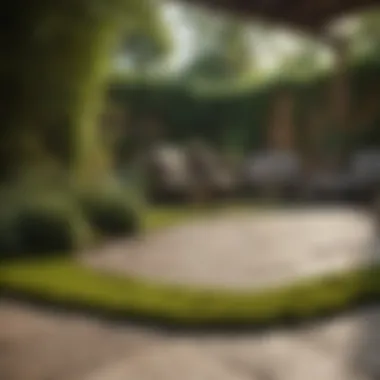Effective Strategies to Prevent Moss in Outdoor Areas


Intro
Moss can be a charming element in nature, adding lushness and softness to a landscape. However, when it takes over our gardens, patios, and lawns, it can transform an outdoor space from a picturesque setting to a tangled mess. Many homeowners find themselves at a loss, wondering what went wrong as moss slowly creeps in, choking the beauty of their yards. Understanding the methods to control and prevent moss growth is crucial for maintaining vibrant, healthy outdoor spaces.
In this article, we will explore effective strategies aimed at thwarting moss growth, delving into various factors that contribute to its proliferation. By examining the conditions that favor moss development, homeowners can take informed measures toward preserving their landscapes. The goal is to equip individuals with practical knowledge to tackle this green invader proactively, ensuring their outdoor spaces remain inviting and beautiful.
Key Insights and Trends
Understanding Moss Growth Conditions
Moss flourishes in specific conditions, particularly in areas that are damp, shaded, and poorly drained. Recognizing these factors is the first step in preventing its unwelcome spread. One might note that regions with heavy tree cover or areas where sunlight struggles to penetrate are often prime real estate for moss. Additionally, if the soil retains moisture or does not drain adequately, moss will find its way to establish itself.
- Shade: Areas left in the lurch of sunlight are often where moss thrives. Trees or structures can block sunlight, creating perfect conditions for this resilient plant.
- Moisture: Regular watering, rainfall, or natural water retention in soil can promote moss growth. Proper drainage is essential.
- Acidic Soil: Moss prefers acidic environments. Testing soil pH can help identify how conducive your garden might be to moss growth.
Current Gardening Techniques
Current gardening trends lean towards creating harmonious outdoor spaces that balance flora and design. Here are some popular methods homeowners are embracing:
- Drought-Tolerant Landscaping: Homeowners are opting for native plants that are more resilient to dry spells. This not only conserves water but also reduces the humidity levels that moss craves.
- Hardscape Elements: Incorporating patios, pathways, and rocks can minimize the areas where moss would typically flourish. The use of porous materials helps with water absorption, preventing excessive moisture.
- Strategic Planting: Choosing the right plants that prefer full sun and resist moss can turn the tide. Placing low-growing ground covers can prevent moss from seizing valuable real estate in your garden.
Practical Tips and How-To Guides
Effective Approaches to Prevent Moss Growth
Homeowners can adopt various strategies to keep moss at bay, focusing on adjustments to environmental conditions, garden maintenance, and a little proactive planning:
- Improve Sunlight Exposure: Prune trees or bushes that block sunlight. Allowing more sun into the garden can drastically reduce moss formation.
- Enhance Drainage: Work on adjusting your soil composition by adding sand or organic matter to improve drainage. Raised garden beds can also be a solution.
- Regular Lawn Care: Mowing the lawn consistently and at the right height can discourage moss. Grass that is kept short tends to outcompete moss for resources.
- Soil Testing: Test your soil pH, and if it leans towards the acidic end, consider lime treatments to balance it. A pH around neutral (6 to 7) is less enticing to moss.
"A proactive maintenance routine can make a world of difference in the battle against moss."
- Remove Existing Moss: If moss has already taken hold, carefully remove it using a rake or a moss killer specific to your lawn type. Always follow product instructions closely.
- Plant Selection: When adding new plants, ensure they suit your garden's lighting and moisture conditions, favoring those that thrive without excessive watering.
Seasonal Maintenance Checklist
To keep your outdoor space moss-free, consider implementing this seasonal checklist:
- Spring: Assess your garden for overgrowth; prune heavily shaded areas.
- Summer: Maintain proper watering levels; help your lawn withstand heat stress.
- Fall: Test soil pH and adjust accordingly; prepare your garden for winter with suitable mulch.
- Winter: Maintaining drainage and inspecting areas for ice buildup can be beneficial.
By embracing these strategies, homeowners can effectively contend with moss and cultivate gardens that flourish. The end goal is an outdoor area that reflects personal style while remaining resilient against growth that detracts from its beauty.
Understanding Moss and Its Growth Conditions
Understanding moss and its growth conditions is crucial for anyone looking to maintain a beautiful outdoor space. Moss can appear unexpectedly, often displacing other plants and making gardens look unkempt. By delving into the nature of moss, its preferred environments, and the specific conditions of soil and moisture that sustain it, homeowners can take preemptive steps to curb its growth. An informed approach leads to healthier outdoor spaces, allowing desired plants to flourish while minimizing moss proliferation.
What is Moss?
Moss is a small, simple, and non-flowering plant. It belongs to the group known as Bryophytes and lacks vascular tissue, which means it doesn’t have the same complex system for transporting water and nutrients like flowering plants do. Interestingly enough, this simplicity helps moss survive in tough conditions where many other plants may struggle. Moss appears as a lush carpet of green and can tolerate varying levels of moisture, making it a surprisingly resilient member of the plant kingdom. It reproduces through spores rather than seeds which aids its spread in suitable conditions.
Why Moss Prefers Certain Environments
Moss has its favorite haunts, and understanding these preferences can go a long way in preventing its unwanted spread. It generally thrives in areas that are cool, damp, and shaded, which explains why you might spot it in corners of your garden that receive minimal sunlight, or beneath leafy canopies. The relationship between moss and these environmental factors is intricate.
- Humidity: Moss enjoys humid weather, which allows it to absorb moisture directly from the air.
- Shade: Direct sunlight can be detrimental to moss, which prefers shaded spots. Areas under trees or structures often create the perfect conditions.
- Temperature: Moss tends to flourish in cooler temperatures and can struggle during very hot or dry spells.
"To prevent moss, think like a moss. Understand its world, and you can protect yours."
The Role of Soil and Moisture
Soil plays a fundamental role in moss emergence. Generally, moss adapts well to poor soils where nutrients may be limited, provided that moisture levels are appropriate. If the soil is acidic and consistently wet, that's like hitting the jackpot for moss production.
- Soil pH: Moss often prefers acidic soils. If your outdoor space has a pH lower than 6.0, you might find moss comfortably settled in.
- Compacted Soil: Compaction limits air and water movement, retaining too much moisture and creating a welcoming environment for moss.
- Moisture Retention: The ability of the soil to hold moisture directly influences the growth of moss. Sandy soils might dry out too quickly, while dense clay can retain water excessively, both of which influence the dynamics of moss growth.
In essence, keeping an eye on these factors can help you understand why moss may be establishing itself in your outdoor space, and inform your strategies to manage it effectively.


Assessment of Your Outdoor Space
Assessing your outdoor space is a crucial step in combating the unwelcome invasion of moss. It's not just about aesthetics; understanding your landscape’s unique characteristics can be the key to proactive management. Addressing factors like moisture levels, sunlight exposure, and soil quality allows homeowners to devise practical solutions tailored to their gardens and patios. This meticulous assessment enables one to identify potential problem areas before moss takes hold, thereby preserving the beauty and integrity of your outdoor spaces.
Identifying Areas Prone to Moss Growth
Moss is rather choosy about where it sets up camp. It tends to favor dimly lit nooks, wet corners, and patches with poor air circulation. Begin by conducting a visual survey of your yard. Are there spots where water tends to pool after rain? Do some areas receive little sunlight due to overhanging branches? Taking notes of such locations can guide you toward areas requiring special attention—like those shady sections under the large oak tree or near the leaky garden hose.
A mental map of your garden can also help in predicting potential moss growth. Keeping an eye on seasonal changes is essential; trucks, fences, and even the direction of winds can add to moisture levels in specific zones. It isn’t just about the aesthetics of the trails and walkways; you will want to mark especially damp areas, as well, to devise prevention strategies effectively.
Analyzing Light and Shade Patterns
Consideration of light is vital in the quest against moss. The availability of sunlight plays a significant role in plant growth, including moss. One must regularly assess how the sun approaches your outdoor spaces throughout the day. A shadow cast by nearby structures or trees can create perpetual dampness, giving moss the upper hand.
To analyze light and shade, jot down the sunlight exposure for each section of your garden. Think about bringing in some direct light where it's sparse. This might involve trimming back those branches that are blocking the sunlight or even moving potted plants into brighter spots. More sun means drier conditions, which makes it harder for moss to thrive.
Evaluating Soil Conditions
Soil conditions are the unsung heroes in moss prevention. Inadequate drainage, high acidity, or compacted soil can create a veritable paradise for moss. Here's the trick: dig a little deeper to understand your soil's composition. Grab a handful and feel its texture. Is it mostly clay, sandy, or loamy? Each has its implications for moisture retention.
Furthermore, testing the pH levels of your soil can reveal whether it's too acidic—a common desire for moss. Ideally, the pH range should hover around 6.0 to 7.0 for most plants. If your soil is on the acidic side, consider applying lime to balance it out. Not only does this deter moss, but it also benefits the overall plant health in your garden, creating a more vibrant ecosystem.
By being attentive to the specific features of your outdoor space, and making informed adjustments according to the findings during your assessments, you empower yourself with a clear path to preventing moss from gaining a foothold in your cherished landscapes.
Best Practices for Moss Prevention
Preventing moss growth is crucial for maintaining the aesthetics and health of outdoor spaces. Given that moss thrives in specific conditions, adopting best practices for prevention can transform gardens, lawns, and patios into vibrant and inviting areas. These strategies not only enhance the visual appeal but also contribute to the overall well-being of the landscape. Homeowners can take proactive steps that save time and effort in the long run, minimizing the need for reactive measures once moss has established itself.
Enhancing Sunlight Exposure
Maximizing the sunlight that reaches your outdoor areas is one of the simplest yet most effective tactics against moss. Moss typically flourishes in shady spots, so ensuring that garden beds and lawns receive enough sunlight can significantly reduce its chances of taking hold.
Some key methods to enhance sunlight exposure include:
- Trimming Trees and Shrubs: Regularly prune overgrown branches and foliage that cast excessive shade. This not only opens up your space but also promotes better air circulation.
- Strategic Plant Placement: When designing your garden, consider the sun's trajectory. Plant sun-loving species in areas that naturally receive direct sunlight, while placing shade-tolerant plants in darker spots.
- Using Reflective Surfaces: Consider incorporating light-colored hardscaping elements like gravel or stones. These reflect sunlight, potentially brightening even the shadiest areas.
"Light and space are the cornerstones of any successful outdoor design".
Improving Drainage and Soil Aeration
Proper drainage and aeration are essential in preventing moss growth. Excess moisture can create the ideal environment for moss to spread, so taking steps to manage water flow in your garden is vital. The following practices can bolster drainage and aeration:
- Installing French Drains: These can redirect excess water away from susceptible areas, preventing soil saturation and creating a less hospitable environment for moss.
- Aerating the Lawn: Regularly aerate your lawn to promote better water penetration and alleviate compacted soil. Aeration improves soil structure, fostering the growth of desired grass and preventing moisture accumulations that moss favors.
- Using Appropriate Soil Mixes: Choose soil blends that allow for adequate drainage, especially in flower beds and vegetable gardens. Amending soil with compost can help improve its structure and drainage capacity.
Utilizing Appropriate Vegetation
The choice of plants can significantly influence the likelihood of moss growth in your outdoor areas. Incorporating species that compete well with moss can help sustain a healthy ecosystem in your garden. Here are some strategies:
- Opt for Drought-Resistant Plants: These species require less water and thrive in drier conditions—making them less susceptible to moss infestation. For example, succulents or certain ornamental grasses can thrive, reducing moss-friendly conditions.
- Incorporate Ground Covers: Planting vigorous ground covers like creeping thyme or clover can overshadow moss and make it harder for it to establish itself.
- Native Plants: Native species are often well-adapted to local conditions, making them more resilient against pests and diseases, which can help in maintaining a less moss-prone environment.
Taking these preventative measures against moss establishes a foundation for a resilient, flourishing outdoor space. Each step not only combats the immediate moss threat but also encourages a healthier and more sustainable gardening practice.
Cultural Control Methods
Addressing moss growth is not merely about applying harsh chemicals or eradicating the problem entirely. Cultural control methods focus on proactive steps that create less suitable conditions for moss to thrive. These methods are integral to long-term management and work in tandem with more conventional practices.
Adopting suitable cultural controls is essential in shaping your outdoor space into a healthy and attractive environment. By instilling necessary habits and maintenance routines, homeowners can greatly reduce the likelihood of moss establishing itself and spreading.
Regular Maintenance Practices
When it comes to outdoor care, consistency is key. Regular maintenance practices play a significant role in preventing moss growth. This means committing to a schedule that includes mowing, trimming, and weeding.
Mowing your lawn to an appropriate height not only boosts its appearance but also encourages grass to become denser. A thicker lawn competes more fiercely against moss, essentially choking it out. Moreover, removing any debris or fallen leaves helps mitigate moisture retention, something moss adores.
Here are some vital maintenance tips:


- Mow regularly to keep grass at a healthy height—aiming for about three inches.
- Edge your garden beds to keep them tidy and reduce the chance of moss encroaching from surrounding areas.
- Weed frequently; less competition from unwanted plants translates to improved conditions for lawn health.
Optimal Lawn Care Techniques
Lawn care techniques weigh heavily on the wellbeing of a garden. Cultivating the right lawn care practices fosters an environment that is unwelcoming to moss.
Fertilizing the soil appropriately can enhance grass health and vigor, preventing moss from taking hold. It’s wise to use a balanced fertilizer to ensure that the grass receives the essential nutrients it needs. Keep in mind that too much nitrogen can lead to grass that grows too quickly, leading to excess clippings and decay that promotes moisture—another boon for moss.
Watering practices are equally important. Water deeply but less frequently, encouraging roots to grow deeper rather than spreading on the surface where moss might thrive. Timing is crucial; watering in the morning allows grass blades to dry before evening.
Mulching Techniques for Moss Prevention
Mulching can serve more purposes than just decoration—it acts as a preventive measure against moss too. Using mulch smartly can assist in regulating moisture levels, suppressing weed growth, and enhancing soil health.
Applying an organic mulch, such as shredded bark or wood chips, can help absorb excess moisture, thus reducing a favorite environment of moss. Furthermore, mulching encourages earthworm activity and enhances soil conditions, which creates a less welcoming environment for moss growth.
Consider these techniques when mulching to maximize benefits:
- Layer mulch appropriately—aim for about two to four inches, which helps retain moisture but does not suffocate the soil.
- Keep mulch away from plant stems to prevent rot and encourage air circulation.
- Renew mulch regularly to maintain its effectiveness and prevent it from breaking down into a layer that retains too much moisture.
By employing these cultural control methods, you will not only keep moss at bay but also cultivate a healthier outdoor environment overall.
Through these strategies, the shift from reactive to proactive maintenance becomes evident, providing homeowners with the tools necessary to combat moss growth effectively.
Chemical and Organic Treatments
Moss can be quite the nuisance in outdoor spaces, often making once vibrant gardens and lawns appear dull and uninviting. To tackle the problem effectively, homeowners may consider both chemical and organic treatments. This dual approach allows for flexibility in managing moss while keeping the overall health of the environment in mind. It’s essential to understand that each method carries its weight, so weighing the benefits and considerations will help in making an informed decision.
Selection of Effective Moss Killers
When it comes to chemical treatments, selecting the right moss killer is crucial. These products are often formulated with specific active ingredients designed to target moss directly. Brands such as Scotts Moss Control or PBI Gordon Moss-Out are often recommended. They contain compounds like potassium salts of fatty acids or ferrous sulfate, which work by drying out the moss and disrupting its cellular structure.
However, before applying these products, it’s important to read the label thoroughly. Here’s a handy checklist for selecting effective moss killers:
- Active Ingredients: Research the chemicals and their effects on surrounding plants.
- Application Method: Choose one that fits your gardening style—liquid sprays, granules, or concentrated solutions.
- Environmental Impact: Look for options that minimize harm to beneficial insects and other flora.
By paying close attention to these factors, homeowners can effectively reduce moss growth while keeping the rest of their garden safe.
Organic Alternatives to Chemical Treatments
For those leaning towards a more eco-friendly route, there are several organic alternatives available. These methods not only help in removing moss but also promote the health of your outdoor space. Some popular organic solutions include:
- Vinegar: A common household item, vinegar's acetic acid can effectively kill moss when applied directly.
- Baking Soda: Sprinkling baking soda in moss-prone areas can disrupt moss growth.
- Corn Gluten Meal: This natural herbicide prevents moss from germinating while enriching the soil.
Admittedly, organic options might not have the same instant or dramatic effects as chemical treatments, but they offer long-term benefits for the soil and surrounding plants. They’re less likely to leach into groundwater or harm non-target species, making them a solid choice for environmentally-conscious homeowners.
Application Guidelines and Safety Precautions
When applying any treatment—be it chemical or organic—safety should be a top priority. Here are essential guidelines to follow:
- Weather Conditions: Choose a calm, dry day to apply treatments. Rain can wash away chemicals, and windy conditions can spread them unintentionally.
- Protective Gear: Always wear gloves, long sleeves, and goggles. Even organic treatments can irritate the skin or eyes.
- Follow Instructions: Adhering to the manufacturer’s directions is crucial. Over-application can harm plants or create an uneven treatment of the area.
- Keep Pets and Children Away: After treatment, ensure that pets and kids stay clear of the treated areas for safety.
Important: Always test a small patch before applying treatments widely, ensuring no adverse effects on desired foliage.
Long-term Strategies for Management
Long-term strategies in managing moss growth are essential for the upkeep of outdoor spaces. Homeowners must recognize that addressing moss problems isn't just a one-time fix. Instead, it requires ongoing attention and smart practices tailored to specific environments. The benefits of implementing these strategies include not only a reduction in moss but also an overall healthier ecosystem for plants and grass. Regular management helps in sustaining the aesthetic appeal and functionality of gardens and lawns.
Monitoring Moisture Levels Continuously
Keeping an eye on moisture levels is crucial in stopping moss in its tracks. Too much moisture leads to perfect conditions for moss to flourish. Homeowners can employ various methods to facilitate moisture management.
- Utilize a moisture meter: This tool helps gauge the soil’s moisture content, informing when to water plants and when to back off to prevent over-watering.
- Observe rainfall patterns: Regularly checking local weather forecasts can help anticipate natural water influx, allowing adjustments in watering schedules.
- Employ soil moisture sensors: These can be set up to provide real-time data, sending alerts when soil moisture is high, which can help in making informed watering choices.


"Understanding moisture levels is like having a behind-the-scenes pass to your garden's health. It’s key to preventing unwanted guests like moss."
Regular Soil Testing and Amendments
Soil testing cannot be overlooked in the quest for moss prevention. Analyzing soil composition and pH levels lets homeowners know which amendments are necessary.
- Conduct soil tests annually: Basic soil tests can reveal nutrient levels, pH, and organic matter content. This can pinpoint any deficiencies that might favor moss.
- Add organic matter: Incorporating compost can improve soil structure and drainage, reducing the susceptibility to moss growth.
- Adjust pH levels: Since moss prefers acidic conditions, maintaining a neutral or slightly alkaline pH (around 6 to 7) through lime applications can be a good strategy.
Creating a Barrier Against Moss Regrowth
Establishing preventive measures against moss regrowth is another pivotal element of long-term management. By being proactive, homeowners can reduce the likelihood of moss reestablishing.
- Install barriers: Physical barriers such as landscape fabric or stones can be effective in blocking moss spores from taking root, especially in shaded areas prone to moss.
- Plant vegetation strategically: Dense plant cover can shade the ground and absorb excess moisture while preventing moss from getting a foothold. Consider resilient groundcovers like creeping thyme or clover.
- Implement a maintenance schedule: Regularly maintaining landscapes—removing debris, trimming excessive shading from trees, and aerating soil—creates a less hospitable environment for moss.
Implementing these long-term strategies transforms the landscape into a thorny bastion against moss, allowing your outdoor spaces to breathe beautifully—all while planning ahead to manage moisture, enrich your soil, and create effective barriers. This proactive approach not only guards against moss but also promotes vibrant and flourishing greenery.
Case Studies of Successful Moss Prevention
Examining successful case studies on moss prevention provides more than just anecdotal evidence; it shines a light on practical applications of strategies that are backed by real-life results. By looking at how others have tackled moss growth, homeowners and garden enthusiasts can adopt proven approaches tailored to their own unique outdoor spaces. Each case offers insights not only into what worked but also the challenges faced, allowing for a deeper understanding of how to customize methods and overcome potential setbacks.
Residential Gardens: A Comprehensive Approach
In the realm of residential gardens, the comprehensive approach of Jill Thompson from Oregon serves as an illuminating model. Faced with a damp, shaded yard that was falling prey to aggressive moss growth, she realized that a broad-spectrum strategy was necessary.
Key elements of her approach included:
- Sunlight Optimization: Jill started by strategically pruning trees to increase light penetration into the garden. This move brought a significant transformation, making it less of a cozy habitat for moss and more conducive for her chosen plants.
- Drainage Enhancement: She also installed several drainage pipes and utilized gravel to improve water runoff, preventing accumulation. An eye for detail was crucial here—she ensured that any slopes directed water away from the garden beds.
- Soil Health Monitoring: Regular soil testing, which Jill emphasized, deterred the dormant moss from waking up due to nutrient imbalance. By maintaining the right soil pH and richness, she observed a marked reduction in moss resurgence.
Overall, Jill's journey with her garden not only led to a visually appealing outdoor space sans moss, but it also fostered a vibrant ecosystem of various flowering plants.
Public Parks: Collaboration and Strategy
Public spaces like Green Valley Park in Florida highlight the collective effort and collaborative strategies that can effectively tackle moss issues. The local government, in partnership with environmental groups, devised a plan that involved both community engagement and scientific insight.
Highlights of their strategy included:
- Community Workshops: Residents were invited to workshops that educated them on moss biology and prevention methods. This camaraderie not only raised awareness but also empowered locals to take charge of their environment.
- Plant Diversity Initiatives: The parks department introduced a range of native plants that thrived in the local climate while overshadowing the moss. This natural competition played a vital role in controlling moss coverage.
- Routine Assessments: An ongoing assessment approach was implemented, which allowed park officials to monitor problem areas continually. With this insight, they could adapt their strategies more effectively over time to fit the evolving landscape.
Furthermore, their collaborative efforts underscored how community participation could drive successful outcomes for public spaces. Observers noted that the park flourished not just in the absence of moss, but in the vitality of its flora and fauna.
“A garden is a reflection of its gardener. The care and strategies put into it resonate in every leaf and flower.”
In sum, these case studies present a multifaceted approach that encourages homeowners and communities alike. Moss prevention in outdoor spaces requires not just singular fixes but a holistic understanding of the interplay between sunlight, drainage, soil health, and the presence of plant life. Engaging these methods can ameliorate not just individual gardens, but also public environments, ultimately elevating the beauty and functionality of outdoor spaces.
Finale
In wrapping up this exploration of methods to prevent moss growth, it's vital to stress just how impactful proactive measures can be for maintaining outdoor aesthetics and health. The prevalence of moss can often bewilder homeowners, but by diving into the strategies discussed, anyone can set the stage for a vibrant outdoor space. It’s not just about removing moss when it's there; it’s about creating an environment that simply doesn't lend itself to that growth in the first place. The interplay of sunlight, moisture, and soil structure are critical elements that can dictate whether moss will take root or not.
Recapitulation of Key Points
1. Understanding Your Environment
- Moss thrives in specific conditions, often attracted to damp, shaded spaces with poor drainage. Being aware of where these conditions manifest allows you to act accordingly.
2. Best Practices for Prevention
- Ensuring adequate sunlight exposure and good drainage can significantly deter moss. Consider that every plant and patch of soil can play a role in this holistic approach.
3. Maintenance Matters
- Regular upkeep, from mowing to soil testing, is not just good practice; it is essential. Keeping your outdoor space in optimal condition can serve as the first line of defense against moss.
Encouragement for Proactive Measures
Taking action before moss becomes a problem is not just wise; it’s necessary. Consider integrating a set of ongoing maintenance habits into your routine. For example:
- Monitor moisture levels in your soil consistently.
- Opt for vegetation that complements sunlight exposure and soil type.
- Invest in soil amendments or treatments that foster drainage and structure.
"An ounce of prevention is worth a pound of cure." Taking steps now to cultivate the right environment can save you headaches down the line. So whether you’re tending a charming garden or simply keeping your lawn in check, stay ahead of potential moss issues with the knowledge and strategies laid out here. It’s all about creating an ecosystem that leaves no room for moss to encroach.
With these practices, you’ll not only enjoy a more appealing patio or garden space but also foster a landscape that thrives. Be proactive, stay observant, and you’ll relish the beauty of your outdoor spaces year-round.



